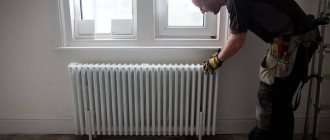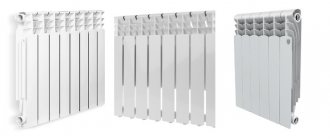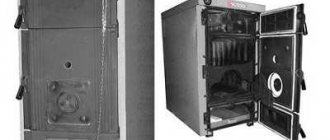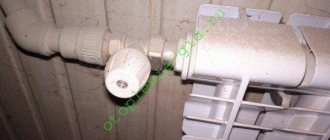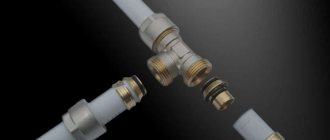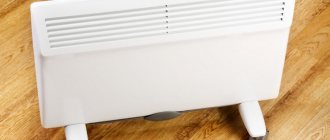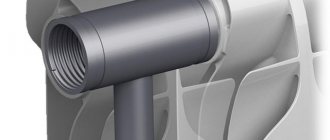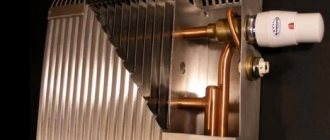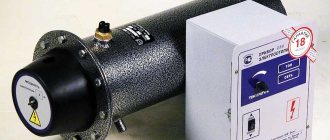Cast iron radiators have been squeezed out of the market by the influx of modern developments in the field of heating devices, but continue to pose serious competition to new products. When choosing, it is important to consider the weight of a cast iron battery, since this parameter affects the complexity of installation and installation principles.
For a classic sectional radiator, the weight of 1 element is 7.5 kg, that is, a standard design of 7 elements will weigh more than 50 kg.
Classic cast iron radiator
This raises two problems
:
- it is difficult to install a reliable wall mount if the walls are made of porous light blocks or are a frame structure - you will need to install the heating device on the floor;
- It is necessary to carry the battery together and very carefully, since the impact causes microcracks to appear in the fragile cast iron, which expand under the influence of the heated coolant - over time, this provokes depressurization of the heating device.
Heat dissipation of a cast iron radiator
The power of a cast iron radiator directly depends on the area of its outer surface and lies in the ability to release heat energy at the highest possible coolant temperature. Basically, this value ranges from 80 to 200 watts per section . To calculate the required power, the following formula is used: for 25-30 cubic meters. m. battery power should be 1 kW . If there are several external walls, the power indicator increases.
Basic calculations
When designing a heating system, it is necessary to calculate the weight of the radiator and the required number of sections in the batteries. Calculations are made based on the power of one section of the heating device (for a classic cast iron product this is 170 W) and the thermal calculation of the room.
To calculate the required number of sections and the final weight of a cast iron radiator, you should take into account the area and heat loss of the room, which depend on the characteristics of the materials from which the walls are built and the presence of insulation. You also need to pay attention to the number of windows and the type of window systems.
For a panel house, the optimal heat flow value is 0.041 kW/m3, for a brick house - 0.034 kW/m3, for buildings with insulated walls (regardless of the material from which they are built) - 0.02 kW/m3.
Considering the considerable weight of one section of a cast iron battery, the number of links in a standard radiator varies from 4 to 10. In a large room, it is more convenient to install two or three heating devices of 4-5 sections instead of installing one extremely heavy radiator with the number of links more than 10 .
Dimensions of a cast iron radiator.
In the Soviet Union, the overall dimensions of cast iron radiators had a certain standard. In one section, the distance between the centers of the coolant supply and discharge pipes ranged from 30 to 50 cm. The width of the section was not standardized and varied among different manufacturers. Almost all modern batteries also have these standards. The most popular model among cast iron products is MS-140. (installed in many “Khrushchev” and 9-story buildings of the 60-80s). The distance between the centers of the pipes is 50 cm; battery height 58.8 cm; width 9.3 cm; depth - 14 cm. The variety of overall dimensions of batteries is explained by the needs of customers.
What to consider when choosing a bath
When choosing a cast iron hot tub, you need to consider the following recommendations.
- Like any other bathtub, it needs to be selected according to size . In a cramped room, only a rectangular modification with minimal or medium dimensions will fit. In a spacious room there is more choice.
- The wall thickness in modern models is 5–6 cm. Such bathtubs are lighter and easier to install. Products with a wall thickness of 4 cm already do not retain heat well.
- The thickness of the enamel is 1–1.2 cm, without chips or scratches.
Preference is given to options with anti-slip coating and handrails.
Manufacturers of cast iron radiators
Most of the Russian market is represented by domestic models. This can be explained by the fact that the cost of transporting cast iron batteries makes up a large part of its final cost. The main manufacturers include:
- CHAZ – Cheboksary Aggregate Plant (Russia)
- Minsk Heating Equipment Plant (Belarus)
- Kiran (Ukraine)
- Viadrus (Czech Republic)
Adviсe
How to calculate power?
Before installing heating batteries, it is necessary to calculate the power required in the desired room. Taking into account the fact that, in accordance with building codes, 100 W of thermal energy is required per square meter of a room with standard ceilings of 2.7 meters, we obtain the formula:
K = (Sroom x 100 W) / P, where K is the number of sections, S is the area of the room, P is the power of the section.
Installation Tips
The most useful advice for installing cast iron batteries is to seek help from a professional. But if you are still confident in your abilities and intend to install the equipment yourself, then you should adhere to the following tips:
- determine the middle of the window opening, set aside the distances on both sides to the fasteners;
- place the radiator at a distance of 8-14 cm from the floor - this will facilitate the assembly process and avoid the formation of cold zones;
- so that convection is not disturbed and the thermal power is not reduced, 10-12 cm should be left between the window sill and the battery;
- the gap between the wall and the installation is 3-5 cm.
Self-installation steps:
- screw the air vent into the adapter and place it on the upper manifold opposite the supply pipe connection area;
- install plugs on the collectors;
- install shut-off and control valves;
- connect the pipelines;
- When performing pressure testing, open the taps gradually.
Tips for use
The service life of a cast iron heating system is determined by several decades, but with proper operation of cast iron radiators they can last for even longer.
To do this you need:
- install batteries correctly and efficiently;
- flush radiators every season;
- keep elements clean;
- try not to knock on the batteries or hit them with heavy objects.
How to hide?
Above, the not very presentable appearance of cast iron radiators has been noted more than once. Therefore, many owners are concerned about the question of how to harmoniously fit batteries into the interior of the house.
You can use these tips:
- installation of pipes in the walls of the room (possibly implemented during the construction or major renovation stages);
- purchasing in advance aesthetically pleasing modern equipment (the range is varied these days);
- painting in the desired color, decoration;
- installation of hard screens (they can be purchased at plumbing stores);
- use of special dense fabric, which is attached with Velcro to the wall or window sill;
- batteries can be hidden with furniture (this method is suitable for the bathroom and toilet).
Installation of cast iron radiators.
Almost all cast iron products are composite, consisting of separate sections connected by nipple bushings.
Gray cast iron is used in their manufacture. Paronite gaskets are installed between the individual sections. Horizontally, the flow of water always goes in one direction. Vertically, the current flows through channels, of which there are one or more. Depending on the number of vertical channels, the area and power of the battery increases. Due to the need to maintain strength and surface area, manufacturers cannot change the weight-to-power ratio much. The large weight of the battery means reinforced fastenings.
Surface treatment: sanding
Such radiators require frequent painting , as scratches or chips remain on them.
If you change the color of the heating device, repairs may be needed in all rooms. The process of changing the color of a heating device is divided into a couple of stages.
The first stage includes surface preparation. First, wash the battery very thoroughly, remembering to remove traces of dirt between sections.
After that, remove the layer of outdated paint - for this there are a lot of specialized solutions that do not harm the metal. Apply the solution to the heating device with a dry brush and wrap the heating device with film. After an hour, the paint is removed using a spatula. Afterwards, carefully sand the surface of the battery with fine-grained sandpaper and degrease it with a solvent. If there are areas touched by rust on the battery, they are processed to bare metal.
Applying a primer will complete the process of preparing the product - after which they begin painting. The paint will lie on the surface in an attractive, even layer. And the primer will also help fight corrosion.
Coloring
Paint for heating appliances must meet many requirements:
- be resistant to wear and non-toxic;
- maintain a temperature of more than one hundred degrees , for example, which contains iron powder, is the most heat-resistant;
- must be suitable for painting metal surfaces;
- fit under the primer;
- help protect the product from corrosion processes;
- serve for a long time , maintaining color.
Acrylic-based enamels containing organic solvents will give radiators a high-gloss shine and long-lasting color But they have a significant drawback - a sudden foul odor during the paint coating process.
Alkyd-based enamels are laid out evenly and are resistant to abrasion. However, they have an unpleasant odor not only during application, but also for a certain period of time after complete setting when the heating device is heated.
Photo 1. Jar of heat-resistant alkyd enamel for heating radiators, 0.5 l, manufacturer Dali.
To prevent paint drips from spoiling the already painted surface, it is recommended to start painting from the top of the battery.
Main. You need to understand that you cannot paint hot batteries.
Applying a second layer
When the first layer of paint dries (the setting time depends on the quality of the paint, but as a rule, the average is twenty hours ), apply the next layer. This makes it possible to hide irregularities on the surface of the heating device, will increase the resistance of the painted surface to environmental influences and will improve the beautiful appearance of the heating device.
Attention! Do not turn on the batteries until the paint has completely set. You should not artificially speed up the setting process - this will lead to bad consequences.
Advantages of cast iron heating radiators
Heating appliances made of cast iron are very resistant to aggressive coolant environments. This is explained by the physical parameters of this metal. Cast iron radiators can remain corrosion-free for a very long time, even at elevated temperatures. In addition, virtually no harm is caused to cast iron and various chemicals added to the coolant.
If the device becomes clogged or leaks, they can be easily repaired. Blockages that occur in the radiator can be caused by the properties of the coolant with a high content of Ca and Mg salts. As a result of deposits on the inner wall of the device, it narrows, which leads to a deterioration in the heating rate and normal heat transfer. A leak in a cast iron battery can occur as a result of wear of the gaskets between the sections. It is better to eliminate all the problems described above during the summer preventive shutdown of water supply.
The cost of a cast iron battery is approximately equal to the cost of analogues made of aluminum and steel. But at the same time, it is worth noting that cast iron withstands water shocks much better and can withstand pressure surges of about 16 bar.
Cast iron devices can be used at high temperatures and pressures, due to their low coefficient of thermal expansion.
The heat output of the heater is quite high. To achieve the greatest effect from this property, special reflectors should be placed behind the cast iron radiator.
Installation of a cast iron radiator is easy, due to the fact that the radiator sections are connected using a threaded connection and paronite gaskets. The battery is connected to the ends of the pipes in the same way. A special key is used for threading, which can be used to disconnect any section without removing the side ones.
Very long product life of more than 50 years. The only thing is that during this time it is necessary to regularly remove deposits and replace gaskets.
How much does a custom cast iron battery weigh?
Now it has become clear what the weight of the cast iron battery of the series common among consumers is. But the characteristics of non-standard devices vary in terms of cost and weight.
For example, one section of a French-made three-channel floor radiator Guratec Apollo 795 weighs 13.5 kilograms. The product is presented for sale in 7-section batteries, the total weight of which is 94.5 kilograms. When transporting, unloading and installing it, the help of several workers will be required.
The Czech manufacturer Viadrus produces more affordable products. The weight of the Kalor 500×160 cast iron alloy radiator section is 5.6 kilograms.
Before being sold on domestic markets, foreign heating devices must undergo a mandatory certification procedure regarding compliance with GOSTs, but the weight of the section is not taken into account.
Will the ceiling hold up?
The first thing that seems especially important when analyzing this issue is whether special measures are required to strengthen the floors when installing a cast iron bathtub? How many additional supports should be placed under the longitudinal crossbars? Such reflections seem especially relevant for amateur builders who are building a house with wooden floors without professional calculations from a specialist designer.
How much does a container filled with water weigh along with a person? The maximum value is about 700 kg . After calculating the point load on the floor, an approximate figure of 320 kg per 1 m2 is obtained. This value is quite acceptable for reinforced concrete monolithic and prefabricated floors that have a sufficient safety margin.
In the case of frame-type ceilings made of wooden load-bearing elements, you should think about reinforcement. Typically, such measures are carried out in conjunction with waterproofing work necessary for bathroom equipment.
